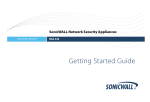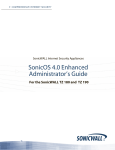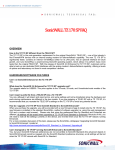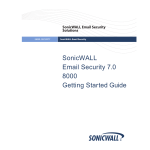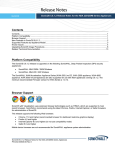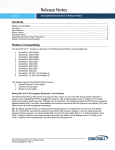Download SonicWALL Home Security System TZ 170 SP User's Manual
Transcript
COMPREHENSIVE INTERNET SECURITY ™ SSSSSSSSSSSSSSonicWALL Security Appliances SonicWALL TZ 170 SP Wireless Getting Started Guide SonicWALL TZ 170 SP Wireless Security Appliance Getting Started Guide The SonicWALL® TZ 170 SP Wireless is a total security platform that delivers enterpriseclass wireless and wired security to small networks, and ensures continuous network uptime for critical, secure data connectivity through integrated and automated fail-over and fail-back. The TZ 170 SP Wireless delivers broadband to analog WAN redundancy, integrates 802.11b/g wireless networks, high-performance deep packet inspection, firewall protection, an IPSec VPN gateway, and support for SonicWALL security services, such as Content Filtering Service, Network Anti-Virus Service, Gateway Anti-Virus, AntiSpyware, and Intrusion Prevention Service. This Getting Started Guide provides instructions for basic installation and configuration of the SonicWALL TZ 170 SP Wireless running SonicOS Enhanced. After you complete this guide, computers on your Local Area Network (LAN) will have secure Internet access. Note: For complete documentation, refer to the SonicOS Enhanced Administrator’s Guide on the SonicWALL Resource CD or at: <http://www.sonicwall.com/support/documentation.html>. SonicWALL TZ 170 SP Wireless Configuration Steps 1 Before You Begin 2 page 2 Setting Up the SonicWALL TZ 170 SP Wireless page 6 3 Connecting the SonicWALL TZ 170 SP Wireless page 8 4 Accessing the Management Interface page 9 5 Using the SonicWALL Setup Wizard page 10 6 Testing Your Connection page 19 7 Registering Your SonicWALL TZ 170 SP Wireless page 20 8 Activating SonicWALL Security Services page 23 9 Connecting Wireless Clients to the SonicWALL TZ 170 SP Wireless page 26 10 Connecting Computers to Your SonicWALL TZ 170 SP Wireless page 29 SonicWALL TZ 170 SP Wireless Getting Started Guide Page 1 1 Before You Begin Check Package Contents Any Items Missing? 1. One SonicWALL TZ 170 SP Wireless If any items are missing from your package, security appliance contact: 2. One Getting Started Guide SonicWALL Support Web: <http://www.sonicwall.com/support/> 3. One Release Note 4. One straight-through Ethernet cable 5. One RJ45 CLI cable* 6. One 5 Volt DC power supply 7. One power cord** 8. One mounting kit (not pictured) 9. One pair of antennae 10. One SonicWALL TZ 170 SP Wireless Resource CD *The RJ45 CLI cable is only included with the purchase of a SonicWALL TZ 170 SP Wireless with SonicOS Enhanced. **A power cord is included only with units shipped to North America. ** Das eingeschlossene Netzkabel ist für Gebrauch in Nordamerikas nur vorgehabt. Für Europaïsche Union (EU) Kunden, ist ein Netzkabel nicht eingeschlossen. Page 2 SonicWALL TZ 170 SP Wireless Front and Back Panels Overview Console Port WAN Port Modem Port PoE Indicator Power Light LAN 1-5 Link, Activity Wireless On/Activity opt WiFiSec Enforcement LAN Ports 1-5 Opt Port Power Modem WAN Test Light SonicWALL TZ 170 SP Wireless Getting Started Guide Page 3 Front Panel Feature Description Power Light Indicates the SonicWALL TZ 170 Series appliance is powered on. PoE Indicator Indicates that Power over Ethernet is available. LAN: Link, Activity Indicates a LAN link (green), or LAN activity (blinking) on the specified port. Wireless On/Activity Indicates enabled wireless signal (green), or wireless activity (blinking). WiFiSec Enforcement Indicates that WiFi Security is in place and being enforced. Optional Zone Indicates a link (green), or LAN activity (blinking) on the opt port. WAN Indicates a link (green), or LAN activity (blinking) on the WAN port. Modem Indicates a link (green), or LAN activity (blinking) on the modem port. Test Light Indicates the SonicWALL TZ 170 Series appliance is in test mode. Rear Panel Feature Page 4 Console Port Provides access to command-line interface (only for use with SonicOS Enhanced). Modem Port Provides a primary or failover WAN connection VIA a modem. WAN Port Provides a primary (Ethernet) connection to the Internet (WAN). Optional Port Provides and optional configurable port. LAN Ports Provide multiple connections to your LAN. Power Provides power connection using the supplied power cord and power supply. Collecting Internet Service Provider (ISP) Information Collect the following information about your Internet service: If you connect via You probably use Please record Cable modem, DSL with a router DHCP No Internet connection information usually required.* *Some service providers require a host name. Check with your ISP. Host Name: Home DSL PPPoE User Name: Password: Note: Your ISP may require your user name in the format: [email protected] T1, Static IP IP Address: Subnet Mask: Default Gateway (Router IP Address): Primary DNS: Secondary DNS (optional): PPTP Server Address: User Name: Password: Static broadband, Cable or DSL with a static IP Dial in to a server Note: If you are not using one of the network configurations above, refer to the SonicOS Enhanced Administrator’s Guide. Other Information These are the default settings for accessing your SonicWALL TZ 170 SP Wireless Webbased management interface: User Name: admin Password: (Default: password) Modem Dial-up Access Number: What You Need to Begin • • • A computer to use as a management station for initial configuration of the SonicWALL TZ 170 SP Wireless A Web browser supporting Java and HTTP uploads. Internet Explorer 5.0 or higher, Netscape Navigator 4.7 or higher, Mozilla 1.7 or higher, or Firefox are recommended An Internet connection SonicWALL TZ 170 SP Wireless Getting Started Guide Page 5 2 Setting Up the SonicWALL TZ 170 SP Wireless Physically setting up your SonicWALL security appliance involves: • Installing the Antennas • Adjusting the Antennas • Applying Power • Applying Power with the SonicWALL Power over Ethernet (PoE) Injector Installing the Antennas To use the wireless feature of the SonicWALL TZ 170 SP Wireless, you must install the antennas on the back of the appliance. Remove the antennas from the bag and place one on each connector. Finger tighten the fittings on the connectors. Adjusting the Antennas You can adjust the antennas for best radio reception. In most cases, the antennas should be pointing straight up and perpendicular to the box. Start from that position, and move them until you notice better reception. Certain area, such as the area directly below the SonicWALL TZ 170 SP Wireless, have relatively poorer reception. Page 6 Applying Power Plug the power supply into the back of the SonicWALL security appliance appropriate power outlet. and into an Alert: Only use a SonicWALL-approved 5V, 2.4A power supply. The Power LED on the front panel lights up green when you plug in the power supply. The Test LED lights up and may blink while the SonicWALL TZ 170 SP Wireless performs a series of diagnostic tests. When the Test light is no longer lit, the SonicWALL security appliance is ready. If the Test LED remains lit, restart the SonicWALL security appliance. For more trouble shooting information, refer to the SonicOS Enhanced Administrator’s Guide. Applying Power with the SonicWALL Power over Ethernet (PoE) Injector The SonicWALL TZ 170 SP Wireless can use a regular power supply, or it can get power through the LAN 1 Ethernet port using the an 802.3af standard PoE injector, like the SonicWALL PoE Injector. To apply power with the PoE injector: 1. Plug the power cord of the PoE injector into the power outlet. 2. Connect an Ethernet cable to the Data and Power out port on the PoE Injector and connect the other end of the cable to the LAN 1 port on the back of your SonicWALL TZ 170 SP Wireless. Alert: The PoE Injector Ethernet cable must be inserted into the LAN 1 port only to power the SonicWALL TZ 170 SP Wireless To power source Ethernet cable Data in Data and Power out LAN 1 SonicWALL PoE Injector To LAN SonicWALL TZ 170 SP Wireless Getting Started Guide Page 7 3 Connecting the SonicWALL TZ 170 SP Wireless Connecting the WAN Cable to the Internet Internet DSL or Cable Modem WAN 1. Connect one end of an Ethernet cable to your Internet connection, such as a DSL modem or cable modem. This cable may already be connected between your computer and your modem. If so, disconnect it from your computer, and leave it connected to the Internet. 2. Connect the other end of the cable to the WAN port on the back of your SonicWALL TZ 170 SP Wireless. The WAN LED on the front panel light up indicating an active connection. Connecting the LAN Cable to Your Management Station Management Station LAN port #1 1. Connect one end of an Ethernet cable to the computer you are using to manage the SonicWALL TZ 170 SP Wireless. 2. Connect the other end of the cable to port # 1 on the back of your SonicWALL TZ 170 SP Wireless. The port # 1 LEDs on the front panel light up indicating an active connection. Page 8 Connecting the Modem (Optional) Internet Phone Line Modem If you are using a modem for your primary Internet connection or as a failover for your WAN connection, connect one end of a standard phone cable to your telephone line jack. of the Connect the other end of the cable to the Modem port SonicWALL TZ 170 SP Wireless. The modem LED lights up indicating a connection. 4 Accessing the Management Interface The computer you use to manage the SonicWALL TZ 170 SP Wireless must be set up to accept a dynamic IP address, or have an unused IP address in the 192.168.168.x/24 subnet, such as 192.168.168.20. For instructions on configuring your IP address, see “Connecting Computers to Your SonicWALL TZ 170 SP Wireless” on page 29. To access the Web-based management interface of the SonicWALL TZ 170 SP Wireless: 1. On the computer you just connected, start your Web browser. 2. Enter 192.168.168.168 (the default LAN management IP address) in the Location or Address field. SonicWALL TZ 170 SP Wireless Getting Started Guide Page 9 3. The SonicWALL Setup Wizard launches and guides you through the configuration and setup of your SonicWALL TZ 170 SP Wireless. If the SonicWALL Setup Wizard Does Not Appear If you cannot connect to the SonicWALL TZ 170 SP Wireless or the Setup Wizard does not display, verify the following configurations: • Did you correctly enter the SonicWALL TZ 170 SP Wireless management IP address in your Web browser? • Are the Local Area Connection settings on your computer set to use DHCP or set to a static IP on the 192.168.168.0/24 subnet? See “Connecting Computers to Your SonicWALL TZ 170 SP Wireless” on page 29 for instructions on changing your Local Area Connection settings. • Do you have the Ethernet cable connected to your computer and to the LAN port on your SonicWALL TZ 170 SP Wireless? • Some browsers may not launch the Setup Wizard automatically. In this case, log into SonicWALL TZ 170 SP Wireless using “admin” as the user name and “password” as the password. After you log in, click the Wizards button on the System > Status page. Select Setup to begin configuring your SonicWALL TZ 170 SP Wireless. • Some popup blockers may prevent the launch of the setup wizard. You can temporarily disable your popup blocker, or add the management IP address of your SonicWALL (192.168.168.168 by default) to your popup blocker's allow list. 5 Using the SonicWALL Setup Wizard The SonicWALL Setup Wizard provides user-guided instructions for configuring your SonicWALL TZ 170 SP Wireless. Note: It is important that you have collected any required ISP information before using the Setup Wizard. See the list in Procedure 1, “Collecting Internet Service Provider (ISP) Information” on page 5. Tip: If you do not know what type of Internet connection you have, contact your ISP. In addition, the SonicWALL Setup Wizard will attempt to detect your connection settings. Page 10 Configuring the SonicWALL TZ 170 SP Wireless Welcome - Click Next to begin. 1. Deployment Scenario - Select the wireless deployment scenario that best matches your deployment requirements. Clicking on the deployment scenario link displays a diagram of the deployment to show how the scenario is best used. This Getting Started Guide follows the procedure for setting up an Office Gateway deployment, which is a commonly used wireless deployment for LAN and WLAN to Internet connectivity. For instructions on setting up other wireless network deployments, refer to the SonicOS Enhanced Administrator’s Guide. Select Office Gateway and click Next. 2. Change Password - Change the administrative password. This is the password for the admin account. Old Password Should be populated with the default password, password. New Password Enter your new password. Confirm Re-enter your new password. Note: Keep your new password in a safe place. If you lose your password, you will have to reset the SonicWALL security appliance to factory settings and lose your configuration. For instructions on resetting your SonicWALL security appliance, refer to the SonicOS Enhanced Administrator’s Guide. Click Next. SonicWALL TZ 170 SP Wireless Getting Started Guide Page 11 3. Change Time Zone - Change the Time Zone setting to your local time zone. Time Zone Select the time zone for your location from the list. Automatically adjust clock for daylight saving time Check this setting if you live in an area that observes Daylight Saving Time. Note: It is important that you set the time zone correctly before you register your SonicWALL TZ 170 SP Wireless. Click Next. 4. Configure Modem - Select how you will use the built-in modem. Yes - I will use a dialup account as a backup for the WAN Ethernet connection. Select this option to configure automatic WAN failover to the modem. Yes - Dialup up is my only connection to the Internet. If you select this option, you will not be prompted to configure your WAN settings. No - I will not use the modem at this time. Click Next. 5. WAN Failover Dialup Connection - Enter the information for your dial-up Internet account. Page 12 Phone Number Enter the phone number for your dial-up Internet access. User Name Enter the user name for your dial-up Internet account. Password Enter the password for your dial-up Internet account. Confirm Password Re-enter the password. 6. WAN Network Mode - The Setup Wizard automatically detects most networking modes. If it does not detect a networking mode, you may have a static IP address. See Procedure 1, “Collecting Internet Service Provider (ISP) Information” on page 5. Confirm the selection or select the correct type of network connection for your network. Static IP Select Static IP if you want to give the SonicWALL TZ 170 SP Wireless a specific, unchanging IP address. DHCP Select DHCP if your ISP assigns your computer a dynamic IP address. DHCP is commonly used with cable modems. PPPoE Select PPPoE if your ISP requires a username and password to establish a connection and assign a dynamic address. PPPoE is commonly used with DSL modems. PPTP Select PPTP if you dial into a specific server and log into a VPN to establish a connection. With PPTP, you can have either a static or dynamic IP Address. Click on the yellow link for a networking type to see a definition. Click Next. 7. WAN Network Mode - The second WAN network mode screen configures your WAN settings for the selection you made in the previous screen. Static IP The Setup Wizard screen should display: WAN Network Mode: NAT Enabled (Static IP) SonicWALL WAN IP Address Enter a single, static IP address. This must be in the address range assigned to you by your ISP. WAN Subnet Mask Enter the subnet mask for your network, provided by your ISP. For example, 255.255.255.0. Gateway (Router) Address Enter the IP address of your Internet gateway, provided by your ISP. DNS Server Address Enter the IP address of the DNS server for your network, provided by your ISP. DNS Server Address #2 (optional) You can enter a secondary, back-up DNS server to use if the first one fails. Click Next. SonicWALL TZ 170 SP Wireless Getting Started Guide Page 13 DHCP The Setup Wizard screen should display: WAN Network Mode: NAT with DHCP Client If you selected DHCP, you do not need to enter any WAN networking settings. The network settings are provisioned automatically from a DHCP server. Click Next. PPPoE The Setup Wizard screen should display: WAN Network Mode - NAT with PPPoE Client Obtain an IP Address Automatically Select this if your ISP assigns you a dynamic IP address. Use the following IP Address Select this if your ISP has assigned you a static IP address, and enter the address. PPPoE User Name Enter the user name for your Internet account. Your ISP may require you to enter your username in e-mail address format, including “@” and the domain name, for example, [email protected]. PPPoE Password Enter the password for your Internet account. Inactivity Disconnect (minutes) Check this box if you want the SonicWALL TZ 170 SP Wireless to disconnect from the Internet if there is no traffic for the number of minutes you enter. Click Next. PPTP The Setup Wizard screen should display: WAN Network Mode - NAT with PPTP Client Page 14 PPTP Server IP Address Enter the address of the PPTP server. PPTP User Name Enter your network user name. PPTP Password Enter your network password. Obtain an IP Address Automatically Select this if the server assigns you a dynamic IP address. Use the following IP Address Check this if you have been given a static IP address, and fill in the following three fields. SonicWALL WAN IP Address Enter the static IP address for your connection. WAN Subnet Mask Enter the subnet mask for your connection. Gateway (Router) Address Enter the address of your Internet Gateway. Click Next. 8. LAN Settings - The LAN Settings screen configures your LAN interface. SonicWALL LAN IP Address Accept the default IP address or enter a new IP address of the . LAN interface. Record the address: LAN Subnet Mask Accept the default, or enter a subnet mask for your LAN. By default, your SonicWALL TZ 170 SP Wireless is configured with a LAN network IP address, 192.168.168.168, and subnet mask, 255.255.255.0, which will work well for most installations. In most cases, leave the default LAN IP address and subnet mask unchanged. Note: The LAN IP address is the address you will use to access the SonicWALL TZ 170 SP Wireless management interface. Click Next. 9. LAN DHCP Settings - The LAN DHCP Settings screen allows you to select whether or not to use the DHCP server in the SonicWALL TZ 170 SP Wireless to automatically distribute IP addressing information to computers and other network devices on your LAN. Enable DHCP Server on LAN Leave this checkbox checked to use the DHCP server in the SonicWALL TZ 170 SP Wireless security appliance. Do not select this option if you already have a DHCP server on your network, or if you want to require your network clients to have static IP addresses. LAN Address Range If you enabled the DHCP Server, enter a range of IP addresses in the same subnet as the LAN IP address, or leave the default range unchanged. The default DHCP range will work for most installations. Click Next. SonicWALL TZ 170 SP Wireless Getting Started Guide Page 15 10. WLAN 802.11b/g Settings - The WLAN 802.11b/g Settings screen allows you to configure your wireless network settings. SSID For security reasons, change this setting. Enter a unique name to identify the wireless connection. The SSID can contain up to 32 numbers and letters. Radio Mode Select the transmission standard to use. The default, Mixed, works for most office and home settings. Country Code Select the country where you are deploying this SonicWALL security appliance. This configures the channels used to comply with regulations in your country. Channel Select the broadcast channel you want the SonicWALL security appliance to use. The default, AutoChannel automatically detects the channel with the least interference. See “SonicWALL TZ 170 SP Wireless Security Appliance Regulatory Statement and Safety Instructions” on page 37 for information on authorized channels. Click Next. 11. WiFiSec VPN Client User Authentication - WiFiSec is a SonicWALL wireless security implementation that uses an IPSec VPN to secure wireless network connections. The WiFiSec screen allows you to create a VPN user for your wireless network. User Name Enter a user name for the VPN user. Password Enter a unique password for the user. Confirm Password Re-enter the password. Note: You can add additional users in the SonicWALL security appliance’s Management Interface. Refer to the SonicOS Enhanced Administrator’s Guide for instructions on adding users. Click Next. Page 16 12. Wireless Guest Services - Allows guest users to connect to the Internet without any access to your private network. Enable Wireless Guest Services Check to enable Wireless Guest Services on your network. Account Name Enter the account name your guest users must use to log into Wireless Guest Services. Account Password Enter a password for the guest account. Confirm Password Re-enter the password. Account Lifetime Specify the length of time this account may exist before you need to regenerate it. Session Lifetime Specify the length of time a guest user may be logged in. Note: You can add additional guest accounts in the SonicWALL security appliance’s Management Interface. Refer to the SonicOS Enhanced Administrator’s Guide. Click Next. SonicWALL TZ 170 SP Wireless Getting Started Guide Page 17 13. SonicWALL Configuration Summary - Displays your network configuration information. Confirm that the settings displayed match the information you collected in Procedure 1: “Collecting Internet Service Provider (ISP) Information” on page 5. Click Apply to apply your settings to the SonicWALL security appliance. If you click Cancel, no settings will be applied to the SonicWALL security appliance. The Storing SonicWALL Configuration screen displays during this process. Setup Wizard Complete - Your SonicWALL TZ 170 SP Wireless is now successfully configured for LAN and Internet access. Click Close to exit the Setup Wizard. Page 18 6 Testing Your Connection 1. After you exit the Setup Wizard, the login page reappears, open another Web browser and navigate to: <http://www.sonicwall.com>. If you can view the SonicWALL home page, you have configured your SonicWALL TZ 170 SP Wireless correctly. 2. If you cannot view the SonicWALL home page, try a second URL. 3. If you still cannot view a Web page, try one of these solutions: Restart your Management Station Your management station may need to restart to accept new network settings from the DHCP server in the SonicWALL security appliance. Restart your DSL Modem Your DSL Modem may need to restart to communicate with the DHCP Client in the SonicWALL security appliance. Enter a Host Name in your WAN DHCP Settings If you selected DHCP for your WAN settings, you may need to specify a host name for your connection: a. Check with your ISP to see if a host name is required. b. Go to Procedure 4, “Accessing the Management Interface” on page 9, and use the LAN IP address you set in Procedure 5, Step 6: “LAN Settings” on page 15. c. Log in as “admin” with your administrative password. d. In the menu on the left, click . e. In the Interfaces table, click the configure icon in the WAN line. f. In the Edit Interface ‘WAN’ window, enter the host name and click OK. Run the Setup Wizard Use the Setup Wizard again to reconfigure your network settings: a. Go to Procedure 4, “Accessing the Management Interface” on page 9, and use the LAN IP address you set in Procedure 5, Step 6: “LAN Settings” on page 15. b. Log in as “admin” with your administrative password. c. Click the Wizards button in the top-right corner of the management interface to restart the wizard. d. Select Setup and click Next to start the Setup Wizard. SonicWALL TZ 170 SP Wireless Getting Started Guide Page 19 7 Registering Your SonicWALL TZ 170 SP Wireless Once you have established your Internet connection, it is recommended you register your SonicWALL security appliance at mySonicWALL.com. Registering your SonicWALL security appliance provides the following benefits: • Activate 30-day subscriptions to SonicWALL's - Gateway Anti-Virus, Anti-Spyware, and Intrusion Prevention Service - Content Filtering Service - Network Anti-Virus Service • Activate SonicWALL security service licenses • Access SonicOS firmware updates • Obtain SonicWALL technical support Before You Register Make sure the DNS and Time settings on your SonicWALL TZ 170 SP Wireless are correct when you register the device. Configure Time settings in the System > Time page. Configure DNS settings in the Edit Interface window from the Network > Interfaces page. You need a mySonicWALL.com account to register the SonicWALL TZ 170 SP Wireless. You can create a new mySonicWALL.com account directly from the SonicWALL management interface. If you already have a mysonicWALL.com account, go to “Registering Your SonicWALL TZ 170 SP Wireless” on page 22 to register your appliance. Note: mySonicWALL.com registration information is not sold or shared with any other company. Creating a mySonicWALL.com Account Creating a mySonicWALL.com account is fast, simple, and FREE. Simply complete an online registration form in the SonicWALL TZ 170 SP Wireless management interface. 1. If you are not logged into the SonicWALL TZ 170 SP Wireless management interface log in with the username admin and the administrative password you set in the Setup Wizard. Page 20 2. If the System > Status page is not displaying in the management interface, click System in the left-navigation menu, and then click the Status subfolder. 3. On the System > Status page, in the Security Services section, click the Register link in Your SonicWALL is not registered. Click here to Register your SonicWALL. 4. In the mySonicWALL.com Login page, click the here link in “If you do not have a mySonicWALL account, please click here to create one.” The mySonicWALL.com account form is displayed. 5. In the MySonicWall Account page, enter in your information in the Account Information, Personal Information and Preferences fields. All fields marked with an asterisk (*) are required fields. Note: Remember your username and password to access your mySonicWALL.com account. 6. Click Submit after completing the MySonicWALL Account form. 7. When the mySonicWALL.com server has finished processing your account, you will see a page saying that your account has been created. Click Continue. Congratulations. Your mySonicWALL.com account is activated. SonicWALL TZ 170 SP Wireless Getting Started Guide Page 21 Registering Your SonicWALL TZ 170 SP Wireless 1. If you are not logged into the SonicWALL TZ 170 SP Wireless management interface, log in with the username admin and the administrative password you set in the Setup Wizard. 2. If the System > Status page is not displaying in the management interface, click System in the left-navigation menu, and then click the Status subfolder. 3. On the System > Status page, in the Security Services section, click the Register link. The mySonicWALL.com Login page is displayed. 4. Enter your mySonicWALL.com account username and password in the User Name and Password fields, then click Submit. 5. The next several pages inform you about SonicWALL’s Security Services. Click Continue on each page. 6. At the top of the Product Survey page, Enter a “friendly name” for your SonicWALL content security appliance in the Friendly Name field. The friendly name allows you to easily identify your SonicWALL content security appliance in your mySonicWALL.com account. 7. Please complete the Product Survey. SonicWALL uses this information to further tailor services to fit your needs. 8. Click Submit. 9. When the mySonicWALL.com server has finished processing your registration, you will see a page informing you that your SonicWALL TZ 170 SP Wireless appliance is registered. Click Continue, and the System > Licenses page is displayed showing you all your activated services. Page 22 Congratulations Your SonicWALL TZ 170 SP Wireless is now fully operational. You can continue with this Getting Started Guide to: • Activate SonicWALL Security Services. • Set up secure wireless access to your SonicWALL security appliance. • Set up computers on your network for secure Internet access. • Mount your SonicWALL TZ 170 SP Wireless on a wall, ceiling, or other surface. 8 Activating SonicWALL Security Services When you register your SonicWALL TZ 170 SP Wireless, you are eligible for a Free Trial of the SonicWALL Security Services: • Gateway Anti-Virus/Anti-Spyware/Intrusion Prevention Service - Provides realtime protection for all hosts behind your SonicWALL from viruses, spyware, worms and application-layer attacks using deep packet inspection to detect and prevent malicious content before it can reach hosts on your network. • Network Anti-Virus - Protects hosts on your network from viruses by enforcing the use client-based Anti-Virus software. • Premium Content Filtering Service - Enhances productivity by limiting access to objectionable Web content. At the end of your free trial period, the services will automatically expire unless you purchase a subscription from your reseller or at <https://www.mySonicWALL.com>. Activate the SonicWALL Security Services If your SonicWALL management interface is displaying the Manage Services Online table on the System > Licenses page, skip to Step 5. 1. Log in to your SonicWALL management interface. 2. In the left-navigation menu, click System and then Licenses. 3. Near the bottom of the System > Licenses page, under Manage Security Services Online, click the link: For Free Trials, Click Here. 4. Log in with your mySonicWALL.com account name and password, if prompted. 5. In the Manage Services Online table, click Try in the Free Trial column for Gateway Anti-Virus. 6. In the SonicWALL Gateway Anti-Virus page, click Continue. Your Gateway Anti-Virus, Anti-Spyware, and Intrusion Prevention Service free trial is now activated. 7. In the Manage Services Online table, click Try in the Free Trial column for Network Anti-Virus and for CFS Premium Service to activate the Complete Anti-Virus and Content Filtering Service (CFS) free trials. SonicWALL TZ 170 SP Wireless Getting Started Guide Page 23 Your SonicWALL Security Service free trials are now activated. You must now enable each service on your SonicWALL security appliance. Use the following instructions to configure each service with its default values. For complete configuration instructions, see the administrative guides available on your SonicWALL resource CD and on the Web at: <http://www.sonicwall.com/support/documentation.html>. Enabling Premium Content Filtering Service 1. Select the Security Services > Content Filter page in the SonicWALL management interface. 2. Select the LAN checkbox to apply the filter to all computers on your LAN interface. 3. Click Configure, select the categories to block in the URL List tab, and click OK. 4. Click in the top-right corner of the page. Enabling Network Anti-Virus Service 1. Select the Security Services > Network Anti-Virus page in the SonicWALL management interface. 2. Select the Enable Anti-Virus checkbox. 3. Click in the top-right corner of the page. Users on your network will be prompted to download the SonicWALL Anti-Virus client. Enabling Intrusion Prevention Service 1. Select the Security Services > Intrusion Prevention page in the SonicWALL management interface. 2. In the IPS Global Settings section, click the Enable IPS on Interface checkbox, and check the WAN and LAN interface check boxes. 3. In the Signature Groups table, select Prevent All for High Priority attacks. 4. Click Page 24 in the top-right corner of the page. Enabling Gateway Anti-Virus Service 1. Select the Security Services > Gateway Anti-Virus page in the SonicWALL management interface. 2. In the Gateway Anti-Virus Global Settings section, click the Enable Gateway Anti-Virus on Interface checkbox, and check the WAN and LAN interface boxes. 3. Click in the top-right corner of the page. Enabling Anti-Spyware Service 1. Select the Security Services > Anti-Spyware page in the SonicWALL management interface. 2. In the Gateway Anti-Spyware Global Settings section, click the Enable Anti-Spyware checkbox. 3. Select which interfaces you want to apply Anti-Spyware service on, You can select any combination of WAN, LAN, and OPT. 4. For best protection from spyware, select the Prevent All checkbox for High, Medium, and Low danger levels. This will block all spyware that can be detected. 5. Click in the top-right corner of the page. SonicWALL TZ 170 SP Wireless Getting Started Guide Page 25 9 Connecting Wireless Clients to the SonicWALL TZ 170 SP Wireless For wireless clients to connect to your SonicWALL TZ 170 SP Wireless security appliance, they need: • A wireless network card installed and configured for the SonicWALL security appliance’s service set identifier (SSID), which you set up in Procedure 5: Using the SonicWALL Setup Wizard, Step 8: “WLAN 802.11b/g Settings” on page 16. • SonicWALL Global VPN Client (GVC) or SonicWALL Global Security Client (GSC) installed and configured for a secure wireless connection Connecting to the Wireless Network You connect to the wireless network according to the requirements of your client operating system. Your wireless client may automatically detect and display the SonicWALL security appliance’s SSID in a list of available wireless networks or you may need to manually configure your wireless card with the SonicWALL security appliance’s SSID. Establishing Secure Wireless Connections For a wireless client to securely connect to the SonicWALL TZ 170 SP Wireless using WiFiSec, the SonicWALL Global VPN Client (GVC) or SonicWALL Global Security Client (GSC) must be installed and configured. Installing and configuring SonicWALL GVC involves the following procedures: • “Installing the SonicWALL GVC or SonicWALL GSC Using the Setup Wizard” on page 27 • “Creating an Office Gateway Connection Profile Using the New Connection Wizard” on page 27 • “Establishing a WiFiSec VPN Connection Using the WLAN GroupVPN Policy” on page 28 Page 26 Installing the SonicWALL GVC or SonicWALL GSC Using the Setup Wizard If you do not already have SonicWALL GVC or SonicWALL GSC installed: 1. Insert the SonicWALL Resource CD that came with your SonicWALL security appliance into your computer. 2. Open the Software folder on the SonicWALL Resource CD. 3. Open the SonicWALL Global VPN Client folder. 4. Open the GVC Zip file. 5. Launch setup.exe. 6. Follow the instructions in the GVC Setup Wizard to install SonicWALL GVC. Note: SonicWALL GVC is free to use for WiFiSec secured wireless connections. For remote VPN access through a WAN port, you must have a GVC Client License. For complete product documentation on SonicWALL GVC or SonicWALL GSC, see your Resource CD or visit the SonicWALL Web site at: <http://www.sonicwall.com/support/documentation.html>. Tip: You can download the latest GVC installer at SonicWALL’s product Web site at: <http://help.mysonicwall.com/applications/vpnclient>. Creating an Office Gateway Connection Profile Using the New Connection Wizard 1. In your Windows Start Menu, select Start > Programs > SonicWALL Global VPN Client. The first time you open SonicWALL GVC, the New Connection Wizard automatically launches. If the New Connection Wizard does not display, click the New Connection Wizard icon on the far left side of the toolbar to launch it. Click Next. 2. In the Choose Scenario page, select Office Gateway. Click Next. SonicWALL TZ 170 SP Wireless Getting Started Guide 3. In the Completing the New Connection Wizard page select any of the following options: • Select Create a desktop shortcut to this connection, if you want to create a shortcut icon on your desktop for this VPN connection. • Select Enable this connection when the program is launched, if you want to automatically establish this VPN connection when you launch the SonicWALL Global VPN Client. 4. Click Finish. The new VPN connection policy appears in the SonicWALL Global VPN Client window. If you selected to enable the connection automatically, it will display the Enter Username/Password screen immediately. Establishing a WiFiSec VPN Connection Using the WLAN GroupVPN Policy 1. In the SonicWALL Global VPN Client window, double-click the Office Gateway profile. Depending on your configuration, the Connection Warning dialog box may display. 2. Click Yes to continue. 3. In the Enter Username/Password dialog box, enter the authentication credentials for the user configured on the SonicWALL security appliance’s local user database for access to the WLAN GroupVPN, such as WiFiSec user you created in the Setup Wizard. 4. Click OK. You now have secure wireless access. Note: The status in the GVC window will display Connected when the connection is established. If it displays Enabled, you are not yet authenticated with the VPN. 10 Connecting Computers to Your SonicWALL TZ 170 SP Wireless You can attach up to twenty-five or an unlimited number computers, depending on your license, in any combination of wired and wireless connections to your SonicWALL TZ 170 SP Wireless. WAN LAN 5 LAN 3 LAN 1 LAN 4 LAN 2 Internet Hub Configuring Computers for Your Network with DHCP If you enabled the DHCP Server in the Setup Wizard, each computer on your network must be configured to obtain its IP address dynamically. The following steps provide instruction on changing the Local Area Connection settings for four versions of Microsoft Windows. • Windows XP • Windows 2000 • Windows NT • Windows 98 Note: If you are not using DHCP, refer to the SonicOS Enhanced Administrator’s Guide. SonicWALL TZ 170 SP Wireless Getting Started Guide Page 29 Windows XP 1. Open the Local Area Connection Properties window (Start > Settings > Network Connections on most versions of Windows XP). 2. Right click on the Local Area Connection icon, and select Properties. 3. In the list of connection items, select Internet Protocol (TCP/IP) and click Properties. 4. Select Obtain an IP address automatically. 5. Select Obtain DNS Server automatically. 6. Click OK, and then OK again to apply the settings. Windows 2000 1. From your Windows Start menu, select Settings. 2. Open Network and Dial-up Connections. 3. Right click on the Local Area Connection icon, and select Properties. 4. Highlight Internet Protocol (TCP/IP) and click Properties. 5. Select Obtain an IP address automatically. 6. Select Obtain DNS Server automatically. 7. Click OK, and then OK again to apply the settings. Windows NT 1. From the Start list, highlight Settings and then select Control Panel. 2. Open Network. 3. Double-click TCP/IP in the TCP/IP Properties window. 4. Select Obtain an IP address automatically. 5. Click DNS at the top of the window. 6. Select Obtain DNS Server automatically. 7. Click OK, and then click OK again. 8. Restart the computer to apply the settings. Windows 98 1. In the Start menu, select Settings and then select Control Panel. 2. Open Network. 3. Double-click TCP/IP in the TCP/IP Properties window. 4. Select Obtain IP Address automatically. 5. Click DNS Configuration. 6. Select Obtain DNS Server automatically. 7. Click OK, and then click OK again. Page 30 8. Restart the computer to apply the settings. Static IP If you did not enable the SonicWALL security appliance DHCP server, you must configure each computer with a static IP address from your LAN or WLAN IP address range. After the SonicWALL TZ 170 SP Wireless has restarted, follow the steps below for configuring your network clients running any of the following Microsoft Windows operating systems on your LAN/WLAN: Windows XP 1. Open the Local Area Connection Properties window. 2. Double-click Internet Protocol (TCP/IP) to open the Internet Protocol (TCP/IP) Properties window. 3. Select Use the following IP address and type an IP address from your LAN IP range in the IP address field. 4. Type 255.255.255.0 in the Subnet Mask field. 5. Type the SonicWALL TZ 170 SP Wireless LAN IP Address into the Default Gateway field. 6. Type the DNS IP address in the Preferred DNS Server field. If you have more than one address, type the second one in the Alternate DNS server field. 7. Click OK for the settings to take effect. Windows 2000 1. 2. 3. 4. 5. 6. 7. 8. From your Windows Start menu, select Settings. Open Network and Dial-up Connections. Click Properties. Highlight Internet Protocol (TCP/IP) and click Properties. Select Use the following IP address. Type an IP address from your LAN IP range IP address field. Type 255.255.255.0 in the Subnet field. Type the SonicWALL TZ 170 SP Wireless LAN IP Address into the Default Gateway field. 9. If you have a DNS Server IP address from your ISP, enter it in the Preferred DNS Server field. 10. Click OK for the settings to take effect. SonicWALL TZ 170 SP Wireless Getting Started Guide Page 31 Windows NT 1. 2. 3. 4. 5. 6. 7. 8. 9. 10. 11. From the Start menu, highlight Settings and then select Control Panel. Open Network. Double-click TCP/IP in the TCP/IP Properties window. Select Specify an IP Address. Type an IP address from your LAN IP range in the IP Address field. Type 255.255.255.0 in the Subnet Mask field. Type the SonicWALL TZ 170 SP Wireless LAN IP Address in the Default Gateway field. Click DNS at the top of the window. Type the DNS IP address in the Preferred DNS Server field. If you have more than one address, enter the second one in the Alternate DNS server field. Click OK, and then click OK again. Restart the computer for changes to take effect. Windows 98 1. 2. 3. 4. 5. 6. 7. 8. 9. 10. 11. Page 32 In the Start menu, select Settings and then select Control Panel. Open Network. Double-click TCP/IP in the TCP/IP Properties window. Select Specify an IP Address. Type an IP address from your LAN IP range in the IP Address field. Type 255.255.255.0 in the Subnet Mask field. Type the SonicWALL TZ 170 SP Wireless LAN IP Address in the Default Gateway field. Click DNS Configuration. Type the DNS IP address in the Preferred DNS Server field. If you have more than one address, type the second one in the Alternate DNS server field. Click OK, and then click OK again. Restart the computer for changes to take effect. SonicWALL SonicOS Enhanced Features The following table lists some of the features in SonicOS Enhanced you can implement on your network. Feature SonicWALL Security Services Description Documentation and Configuration Complete the security of your network with SonicWALL Security Services: • SonicWALL Gateway AntiVirus, Anti-Spyware and Intrusion Prevention Service provides intelligent, real-time network security protection against sophisticated application layer and content-based attacks. • SonicWALL Content Filtering Service enforces protection and productivity policies for businesses and schools by employing an innovative rating architecture utilizing a dynamic database to block objectionable Web content. • SonicWALL Network AntiVirus provides maximum prevention with virtually no administrative overhead by enforcing client antivirus policies for every system on the network. Documentation: • The SonicOS Enhanced Administrator’s Guide and the SonicWALL Security Service Administrator’s Guides are available for each security service on the SonicWALL Resource CD and at <http://www.sonicwall.com/support/ documentation.html> • The SonicOS online help. Click in the top right corner of the Security Services > Summary page in the management interface. Configuration: Configure these features using the following SonicOS management interface pages: • Security Services > Summary • Security Services > Content Filter • Security Services > Network Anti-Virus • Security Services > Gateway AntiVirus • Security Services > Intrusion Prevention • Security Services > Anti-Spyware • Security Services > E-Mail Filter • Security Services > RBL Filter • Security Services > Global Security Client • System > Licenses SonicWALL TZ 170 SP Wireless Getting Started Guide Page 33 Feature VPN Secure Wireless Solution Description Documentation and Configuration SonicWALL Global VPN Client provides mobile users with secure, easy-to-use access to mission-critical network resources. The VPN Wizard walks you easily through creation of Site-toSite VPN policies. The SonicWALL management interface automates the creation of GroupVPN policies for each security zone. Documentation: • The SonicOS Enhanced Administrator’s Guide available on the SonicWALL Resource CD and at < <http:// www.sonicwall.com/support/ documentation.html> With SonicWALL’s innovative secure wireless solution, you can take advantage of trusted wireless security by deploying SonicPoint 802.11a/b/g radios to provide secure mobility and wireless LAN connectivity for users on the network. Documentation: • The SonicWALL Secure Wireless Network Integrated Solutions Guide at <http://www.sonicwall.com/support/isg/ swisg.html> • The SonicOS Enhanced Administrator’s Guide available on the SonicWALL Resource CD and at <http://www.sonicwall.com/support/ documentation.html> • The SonicOS online help. Click in the top right corner of the VPN > Settings page in the management interface to view help on VPNs Configuration: Configure this feature using the following SonicOS management interface pages: • The VPN > Settings page • The VPN > Advanced page • The VPN > DHCP over VPN page • The VPN > L2TP Server page • The VPN Wizard • The SonicOS online help. Click in the top right corner of the SonicPoint > SonicPoints page in the management interface. Configuration: Configure this feature using the following SonicOS management interface pages: • The SonicPoint > SonicPoints page • The SonicPoint > Station Status page • The SonicPoint > IDS Page 34 Feature Description Documentation and Configuration Firewall Access Policies SonicOS Enhanced features a powerful combination of network address translation, stateful packet inspection, and object based management capabilities enabling granular control over network traffic. Documentation: • The SonicOS Enhanced Administrator’s Guide available on the SonicWALL Resource CD and at < <http:// www.sonicwall.com/support/ documentation.html> • The SonicOS online help. Click in the top right corner of the Firewall > Access Rules page in the management interface. Configuration: Configure this feature using the following SonicOS management interface page: • The Firewall > Access Rules page SonicWALL TZ 170 SP Wireless Getting Started Guide Page 35 Glossary of Networking Terms Default Gateway - A device on an internetwork that forwards packets to another network. DHCP - Dynamic Host Configuration Protocol allocates IP addresses to computers on the network automatically without assigning a computer a static (fixed) IP address. DNS - Domain Name System, a hierarchical naming system that resolves a domain name with its associated IP address. A DNS server looks up the name of a computer and finds the corresponding IP address. This allows users to access hosts using friendly textbased names instead of IP addresses. These names are called fully qualified domain names (FQDN). IP Address - Internet Protocol Address, a 32 bit number that identifies a computer or other resource on the Internet or on any TCP/IP network. The number is usually expressed as four numbers from 0 to 255 separated by periods, for example, 172.16.31.254. LAN - A Local Area Network is typically a group of computers located at a single location, and is commonly based on the Ethernet architecture. NAT - Network Address Translation, An internet standard that allows your local network to use private IP addresses, which are not recognized on the Internet. The IP address used for the router is the only routable IP address. The computers behind the NAT can access the Internet through the router, but Internet users cannot access the computers behind the router. Packet - A unit of information transmitted over the internet or within any TCP/IP network. Packets have a header, which contains information about the source, destination, and protocol to be used for the data, and a body, which contains the data being transmitted. PPPoE - The Point to Point Protocol over Ethernet supports the transmission of network packets over an analog phone line. Private IP Address - An IP address for a resource in your network that is not known or published outside the zone (for example LAN) where it is located. Public IP Address - An IP address for a resource in your network that is published outside your network to the WAN. Router - A device that routes data between networks through IP address information in the header of the IP packet. A router forwards packets to other routers until the packets reach their destination. The Internet is the largest example of a routed network. Subnet - A portion of a network. Each subnet within a network shares a common network address and is uniquely identified by a subnetwork number. Subnet Mask - A 32-bit number used to separate the network and host sections of an IP address. A subnet mask subdivides an IP network into smaller pieces. An example of a subnet mask might be 255.255.255.248 for subnet with only eight IP addresses. TCP/IP - Transmission Control Protocol/Internet Protocol is the basic communication protocol of the Internet. It supports sending information in packets, and identifies each device with a unique numeric IP address. VPN - A Virtual Private Network is a virtual network that encrypts data and sends it privately over the Internet to protect sensitive information. WAN - A Wide Area Network is a geographically distributed network composed of multiple networks joined into a single large network. The Internet is a global WAN. Page 36 SonicWALL TZ 170 SP Wireless Security Appliance Regulatory Statement and Safety Instructions Regulatory Model/Type Product Name APL14-034 SonicWALL TZ 170 SP Wireless Note: Detailed regulatory information can be found in the electronic file, “SonicWALL_Products_Regulatory_Statement.pdf,” located on the SonicWALL Resource CD provided with the unit. Power Supply Information Models APL14-034 If you need to order a power supply for your SonicWALL TZ 170 SP Wireless, contact SonicWALL Technical Support at 408-752-7819 for a replacement. This product should only be used with a UL listed power supply marked “Class 2” or “LPS”, with an output rated 5 VDC, minimum 2.4 A. Considerations for Mounting the APL14-034 • • • • • • Consideration must be given to the connection of the equipment to the supply circuit and the effect of overloading the circuits has minimal impact on overcurrent protection and supply wiring. Appropriate consideration of equipment nameplate ratings must be used when addressing this concern. A power cord is included only with units shipped to North America. Mount in a location away from direct sunlight and sources of heat. A maximum ambient temperature of 104º F (40º C) is recommended. Route cables away from power lines, fluorescent lighting fixtures, and sources of noise such as radios, transmitters, and broadband amplifiers. Ensure that no water or excessive moisture can enter the unit. Allow unrestricted airflow around the unit and through the vents on the side of the unit. A minimum of 1 inch (25.44mm) clearance is recommended. North American Authorized Channels SonicWALL declares that the APL14-034, when sold in US or Canada is limited to CH1~CH11 by specified firmware controlled in the USA. SonicWALL TZ 170 SP Wireless Getting Started Guide Page 37 Lithium Battery Warning The Lithium Battery used in the SonicWALL security appliance may not be replaced by the user. Return the SonicWALL security appliance to a SonicWALL-authorized service center for replacement with the same or equivalent type recommended by the manufacturer. If, for any reason, the battery or SonicWALL security appliance must be disposed of, do so following the battery manufacturer's instructions. Cable Connections All Ethernet cables are designed for intra-building connection to other equipment. Do not connect these ports directly to communication wiring or other wiring that exits the building where the SonicWALL TZ 170 SP Wireless is located. German Language Regulatory and Safety Instructions Hinweis zur Lithiumbatterie Die in der Internet Security appliance von SonicWALL verwendete Lithiumbatterie darf nicht vom Benutzer ausgetauscht werden. Zum Austauschen der Batterie muss die SonicWALL in ein von SonicWALL autorisiertes Service-Center gebracht werden. Dort wird die Batterie durch denselben oder entsprechenden, vom Hersteller empfohlenen Batterietyp ersetzt. Beachten Sie bei einer Entsorgung der Batterie oder der SonicWALL Internet Security appliance die diesbezüglichen Anweisungen des Herstellers. Kabelverbindungen Alle Ethernet- und RJ45 Konsole-Kabel eignen sich für die Verbindung von Geräten in Innenräumen. Schließen Sie an die Anschlüsse der SonicWALL keine Kabel an, die aus dem Gebäude herausgeführt werden, in dem sich das Gerät befindet. Informationen zur Stromversorgung Sollte das Netzteil nicht im Lieferumfang der SonicWALL enthalten sein, wenden Sie sich diesbezüglich an den technischen Support von SonicWALL (Tel.: +1-408-7527819). Dieses Produkt darf nur in Verbindung mit einem nach den Normen der Underwriter Laboratories, USA als „UL-gelistet“ zugelassenen Netzteil der Kategorie „Class 2“ oder „LPS“ verwendet werden. Ausgang: 5 V Gleichspannung, mind. 2,4 A. Page 38 Weitere Hinweise zur Montage der Modell • • • • • • Wählen Sie für die Montage einen Ort, der keinem direkten Sonnenlicht ausgesetzt ist und sich nicht in der Nähe von Wärmequellen befindet. Die Umgebungstemperatur darf nicht mehr als 40 °C betragen. Führen Sie die Kabel nicht entlang von Stromleitungen, Leuchtstoffröhren und Störquellen wie Funksendern oder Breitbandverstärkern. Ein Netzkabel ist nur mit Einheiten versorgt, die nach Nordamerika geliefert werden. Stellen Sie sicher, dass das Gerät vor Wasser und hoher Luftfeuchtigkeit geschützt ist. Stellen Sie sicher, dass die Luft um das Gerät herum zirkulieren kann und die Lüftungsschlitze an der Seite des Gehäuses frei sind. Hier ist ein Belüftungsabstand von mindestens 26 mm einzuhalten. Vergewissern Sie sich, dass das Gerät sicher im Rack befestigt ist. Insbesondere muss auf nicht direkte Anschlüsse an Stromquellen geachtet werden wie z. B. bei Verwendung von Mehrfachsteckdosen. SonicWALL TZ 170 SP Wireless Getting Started Guide Page 39 Mounting the SonicWALL TZ 170 SP Wireless Wall Mounting the SonicWALL TZ 170 SP Wireless Follow the instructions below to mount the SonicWALL TZ 170 SP Wireless on the wall. 1. Using the mounting plate as a template, mark the places to insert the mounting anchors. 2. Using a #2 Phillips screw driver, press the tip of the anchor into the marked places on the hollow wall. 3. Turn the screwdriver clockwise until the anchor is flush with the wall. Repeat for the second anchor. 4. Insert a #6 x 11/4” pan head Phillips self-tapping screw into each anchor leaving a gap for the mounting plate. Page 40 5. Hang the mounting plate on the screws. Use the middle row of mounting holes. 6. Slide the plate down to the narrowest part of the keyhole so that the mounting plate rests on the screws. 7. Tighten the mounting screws to secure the mounting plate. SonicWALL TZ 170 SP Wireless Getting Started Guide Page 41 8. Snap the SonicWALL TZ 170 SP Wireless onto the mounting plate. Mounting Models the SonicWALL TZ 170 SP Wireless on the Ceiling 1. Locate a metal support to hang the SonicWALL TZ 170 SP Wireless. 2. Using the mounting plate as a template, mark the places to insert the mounting anchors. 3. Drill two holes for #6 x 1-1/4” screws in the marked location. 4. Install the #6 x 1-1/4” self-tapping screws leaving a slight gap for the mounting plate. 5. Hang the mounting plate on the screws. Page 42 6. Slide the plate down to the narrowest part of the keyhole so that the mounting plate rests on the screws. 7. Tighten the mounting screws to secure the mounting plate. 8. Snap the SonicWALL TZ 170 SP Wireless onto the mounting plate. SonicWALL TZ 170 SP Wireless Getting Started Guide Page 43 Montage der Modelle APL11-027, APL11-031, APL14-033, APL14-034, APL14-035 und APL14-036 SonicWALL TZ 170 an einer Wand montieren Befolgen Sie die nachstehenden Anweisungen, um die SonicWALL TZ 170 an einer Wand zu montieren. 1. Verwenden Sie die Montagescheibe als Schablone, um die Stellen für die Montagebolzen zu markieren. 2. Drücken Sie mit Hilfe eines Schraubendrehers (Kreuzschlitz Phillips Nr. 2) die Spitze des Bolzens auf die markierte Stelle an der hohlen Wand. 3. Drehen Sie den Schraubendreher im Uhrzeigersinn, bis der Bolzen bündig mit der Wand abschließt. Wiederholen Sie den Vorgang mit dem zweiten Bolzen. 4. Führen Sie in jeden Bolzen eine Zylinderkopfblechschraube Phillips Nr. 6 x 1-1/4 Zoll (6 x 31,8mm) ein, und lassen Sie die Schraube dabei so weit aus der Wand herausragen, dass die Montageplatte daran aufgehängt werden kann. Page 44 5. Hängen Sie die Montageplatte auf die Schrauben. Verwenden Sie dafür die mittlere Lochreihe. 6. Ziehen Sie die Montageplatte nach unten, so dass sich die Schrauben nun im engsten Bereich der Löcher befinden. 7. Ziehen Sie die Montageschrauben an, um die Montageplatte sicher zu befestigen. SonicWALL TZ 170 SP Wireless Getting Started Guide Page 45 8. Befestigen Sie anschließend die SonicWALL TZ 170 an der Montageplatte. Modelle APL11-027, APL11-031, APL14-033, APL14-034, APL14-035 und APL14-036 an der Decke montieren 1. Um die SonicWALL TZ 170 aufzuhängen, suchen Sie zunächst einen Metallträger als Montageort. 2. Verwenden Sie die Montageplatte als Schablone, um die Stellen für die Montagebolzen zu markieren. 3. Bohren Sie an der markierten Stelle zwei Löcher für die Schrauben Nr. 6 × 1-1/4 Zoll (6 × 31,8 mm). 4. Führen Sie anschließend die Blechschrauben Nr. 6 × 1-1/4 Zoll (6 × 31,8 mm) ein, und lassen Sie die Schrauben dabei so weit aus der Wand herausragen, dass die Montageplatte daran aufgehängt werden kann. 5. Hängen Sie die Montageplatte auf die Schrauben. Page 46 6. Ziehen Sie die Montageplatte nach unten, so dass sich die Schrauben nun im engsten Bereich der Löcher befinden. 7. Ziehen Sie die Montageschrauben an, um die Montageplatte sicher zu befestigen. 8. Befestigen Sie anschließend die SonicWALL TZ 170 an der Montageplatte. SonicWALL TZ 170 SP Wireless Getting Started Guide Page 47 Copyright Notice © 2006 SonicWALL, Inc. All rights reserved. Under the copyright laws, this manual or the software described within, can not be copied, in whole or part, without the written consent of the manufacturer, except in the normal use of the software to make a backup copy. The same proprietary and copyright notices must be affixed to any permitted copies as were affixed to the original. This exception does not allow copies to be made for others, whether or not sold, but all of the material purchased (with all backup copies) can be sold, given, or loaned to another person. Under the law, copying includes translating into another language or format. Specifications and descriptions subject to change without notice. Trademarks SonicWALL is a registered trademark of SonicWALL, Inc. Microsoft Windows 98, Windows NT, Windows 2000, Windows XP, Windows Server 2003, Internet Explorer, and Active Directory are trademarks or registered trademarks of Microsoft Corporation. Netscape is a registered trademark of Netscape Communications Corporation in the United States and other countries. Netscape Navigator and Netscape Communicator are also trademarks of Netscape Communications Corporation and may be registered outside the United States. Adobe, Acrobat, and Acrobat Reader are either registered trademarks or trademarks of Adobe Systems Incorporated in the United States and/or other countries. Mozilla and Firefox are trademarks of the Mozilla Foundation. Other product and company names mentioned herein may be trademarks and/or registered trademarks of their respective companies and are the sole property of their respective manufacturers. Page 48 Notes SonicWALL TZ 170 SP Wireless Getting Started Guide Page 49 Notes Page 50 Notes SonicWALL TZ 170 SP Wireless Getting Started Guide Page 51 Notes Page 52 SonicWALL,Inc. 1143 Borregas Avenue Sunnyvale,CA 94089-1306 T: 408.745.9600 F: 408.745.9300 www.sonicwall.com © 2006 SonicWALL, Inc. SonicWALL is a registered trademark of SonicWALL, Inc. Other product and company names mentioned herein may be trademarks and/ or registered trademarks of their respective companies. Specifications and descriptions subject to change with out notice. P/N 232-000859-01 Rev A 03/06




























































